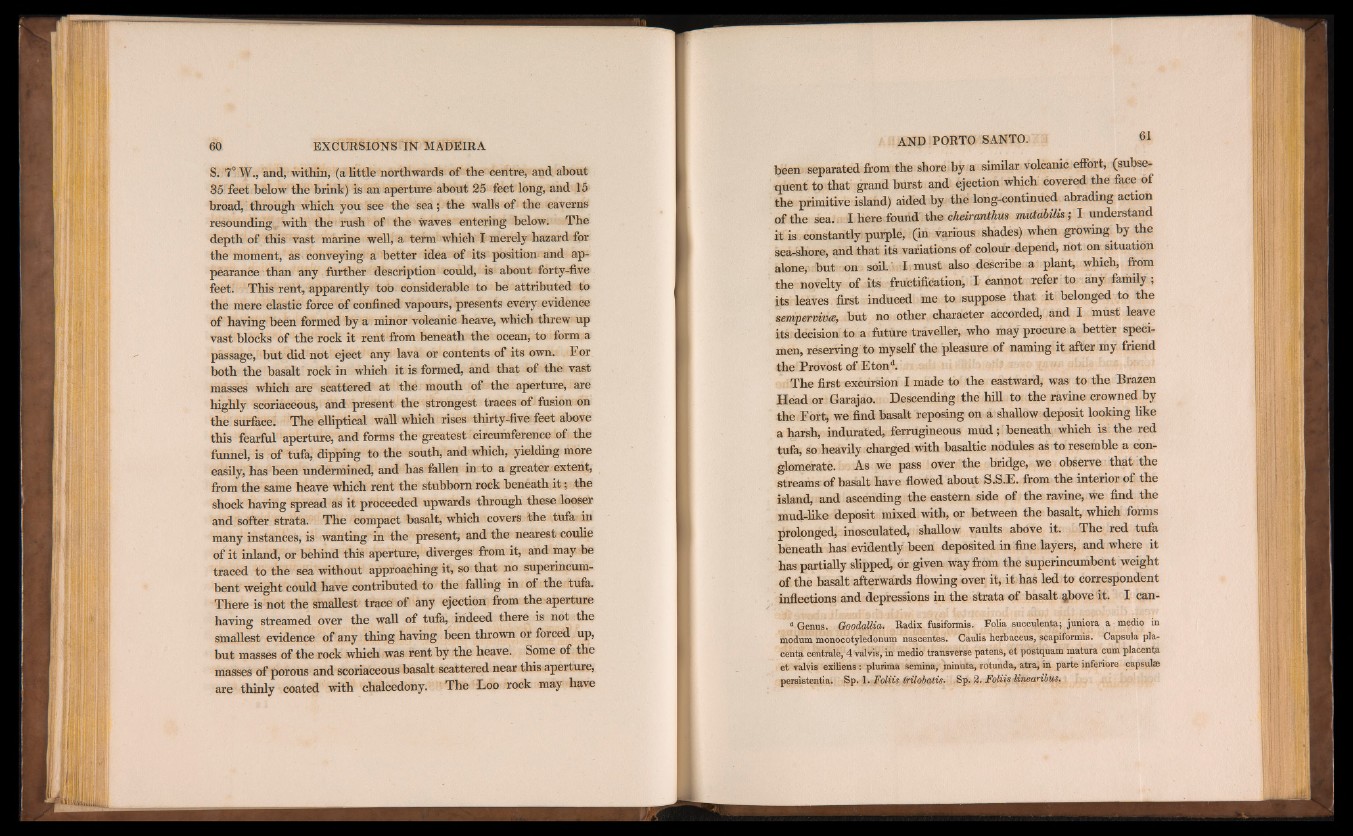
S. 7° W., and, within, (a little northwards of the centre, and about
35 feet below the brink) is an aperture about 25 feet long, and 15
broad, through which you see the sea ;: the walls of the caverns
resounding with the rush of the waves entering below. The
depth of this vast marine well, a term which I merely hazard for
the moment, as conveying a better idea of its position- and appearance
than any further description could, is about forty-five
feet. This rent, apparently too considerable to be attributed to
the mere elastic force of confined vapours, presents every evidence
of having been formed by a minor volcanic heave, which threw up
vast blocks of the rock it rent from beneath the ocean, to form a
passage, but did not eject any lava or contents of its own. For
both the basalt rock in which it is formed, and that of the vast
masses which are scattered at the mouth of the aperture, are
highly scoriaceous, and present the strongest traces of fusion on
the surface. The elliptical wall which rises thirty-five feet above
this fearful aperture, and forms the greatest circumference of the
funnel, is of tufa, dipping to the south, and which, yielding more
easily, has been undermined, and has fallen in to a greater extent,
from the same heave which rent the stubborn rock beneath i t ; the
shock having spread as it proceeded upwards through these looser
and softer strata. The compact basalt, which covers the tufa in
many instances, is wanting in the present, and the nearest coulie
of it inland, or behind this aperture, diverges from it, and may be
traced to the sea without approaching it, so that no superincumbent
weight could have contributed to the falling in of the tufa.
There is not the smallest trace of any ejection from the aperture
having streamed over the wall of tufa, indeed there is not the
smallest evidence of any thing having been thrown or forced up,
but masses of the rock which was rent by the heave. Some of the
masses of porous and scoriaceous basalt scattered near this aperture,
are thinly coated with chalcedony. The Loo rock may have
been separated from the shore by a similar volcanic effort, (subsequent
to that grand burst and ejection which covered the face of
the primitive island) aided by the long-continued abrading action
of the sea.. I here found the cheiranthus mutabilis; I understand
it is constantly purple, (in various shades) when growing by the
sea-shore, and that its variations of colour depend, not on situation
alone, but on soil. I ; must also describe a plant, which, from
the novelty of its fructification, I cannot refer to any family;
its leaves first induced me to suppose that it belonged to the
sempervivte, but no other character accorded, and I must leave
its decision to a future traveller, who may procure a better specimen,
reserving to myself the pleasure of naming it after my friend
the Provost of Etond.
The first excursion I made to the eastward, was to the Brazen
Head or Garajao. Descending the hill to the ravine crowned by
the Fort, we find basalt reposing on a shallow deposit looking like
a harsh, indurated, ferrugineous m ud; beneath which is the red
tufa, so heavily charged with basaltic nodules as to resemble a conglomerate.
As we pass over the bridge, we observe that the
streams of basalt have flowed about S.S.E. from the interior of the
ialnnd, and ascending the eastern side of the ravine, we find the
mud-like deposit mixed with, or between the basalt, which forms
prolonged, inosculated, shallow vaults above it. The red tufa
beneath has evidently been deposited in fine layers, and where it
has partially slipped, or given way from the superincumbent weight
of the basalt afterwards flowing over it, it has led to correspondent
inflections and depressions in the strata of basalt %bove it. I can-
« Genus. Goodallia. Radix fusiformis. Folia succulenta; juniora a medio in
modum monocotyledonum nascentes. Caulis herbaceus, scapiformis. Capsula placenta
centrale, 4 valvis, in medio transverse patens, et postquam matura cum placenta
et valvis exiliens: plurima semina, minuta, rotunda, atra, in parte inferiore capsulae
persistentia. Sp. 1 . Foliis trilobatis■ Sp. 2. Foliis linearibus.